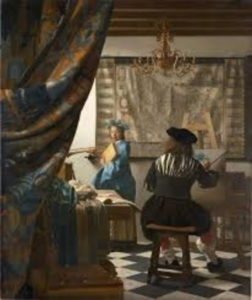
Where does truth lie? If I were Seth Godin, I’d write a clever title about the nexus of truth and artifice… but I’m no such mastermind, so I’ll traverse more plebeian paths instead. I love art. I grew up going on archaeological digs with my family; back in the day when you could dig something out of the ground (in Mexico or Italy, where we often were), put it in your suitcase, and bring it home to the States. That state of entitlement has long since gone, and rightly so.
A little history…. my dad, who lived until he was 95, was an entomologist— a bug guy. Many people confuse entomology with etymology, which is funny in his case because he loved words almost as much as he loved insects. I grew to have a greater love of the latter rather than the former.
Because of his research on flies and disease (for which he was renowned worldwide), we traveled as a family…. many summers to Mexico where he researched the flies that congregated at the slaughterhouses, and in Rome, where he earned the privilege of continuing his research under the Fulbright program.
My parents collected art over the years out of an organic appreciation for culture, and cultures different from their own. Along the way, I was exposed to people from different countries, from all walks of life, and learned about ancient civilizations. My parents schlepped my 3 siblings and me to museums, churches, architectural ruins, theatre, opera, and even bullfights. We were frequently in new situations, in unfamiliar situations. Riding horses into remote villages; stopping by the roadside and being welcomed into the homes of poor farmers who fed us pizza from their outdoor brick ovens. We had a taste of it all thanks to their wanderlust spirit.
Like many of the antiquities they collected, somewhere along the way, I developed a patina…. a thin layer of protection, a veneer, that protected me from the outside world, and kept my inner self safely guarded. This veneer grew to be a fairly permanent part of my persona. It was the ‘pretty’ me. They protected me. It became the professional me until I realized that the truest version of me was behind the curtain of perfection. But learning to remove that patina, to chip away at the veneer has been one of the hardest challenges of my adult life and my professional life. It exposes my most vulnerable self: the person who wasn’t sure she was good enough, smart enough, pretty enough, fast enough, deserving enough. But in today’s ‘conversational, real person’ voiceover world, the microphone wants to hear the real me and none other.
So on to Vermeer and The Art of Painting, also known as The Allegory of Painting, or Painter in his Studio, which is a 17th-century oil on canvas painting by Dutch painter Johannes Vermeer. It is owned by the Austrian Republic and is on display in the Kunsthistorisches Museum in Vienna.
Which reality is true?
The one we see as a spectator witnessing the scene or the one inside the painting itself, in the moment? And isn’t it possible that the subjects of the painting— the painter and his subject, the young woman in the blue dress, are themselves sheathed in garb that protects them from showing their true colors?
This illusionistic painting is one of Vermeer’s most famous and most interesting. Art historian, Svetlana Alpers, described it as unique and ambitious; and expert Walter Liedtke said “it is a virtuoso display of the artist’s power of invention and execution, staged in an imaginary version of his studio.” Many art historians think that it is an allegory of painting, hence the alternative title of the painting. Its composition and iconography make it the most complex Vermeer work of all.
In classical literature one of the best-known allegories is Plato’s Allegory of the Cave. In this work Plato describes a group of people who have lived chained in a cave all of their lives, facing a blank wall. They see shadows projected on a wall in front of them, which are created by a fire behind them… and begin to ascribe forms and names to these shadows, using language to identify their world. According to the allegory, the shadows are as close as the prisoners get to viewing reality, until one of them finds his way into the outside world where he sees the actual objects that produced the shadows. He tries to tell the people in the cave of his discovery, but they do not believe him and worse, resist his efforts to free them from the cave so they can see for themselves. The philosopher finds greater knowledge outside the ‘cave of human understanding’, and he seeks to share it and enlighten the dwellers, but they think they are educated enough and ignore his entreaties, and remain in the dark, believing in the reality of their world as they know it.
Pondering these alternative realities, these layers of truth calls into question where the essence of truth lies. Is my only truth inside me, or outside of me? Where does your truth lie?
Definition of veneer:
1: a thin sheet of a material: such as
a : a layer of wood of superior value or excellent grain to be glued to an inferior wood
b : any of the thin layers bonded together to form plywood
c : a plastic or porcelain coating bonded to the surface of a cosmetically imperfect tooth
2: a protective or ornamental facing (as of brick or stone)
3: a superficial or deceptively attractive appearance, display, or effect : facade, gloss a veneer of tolerance